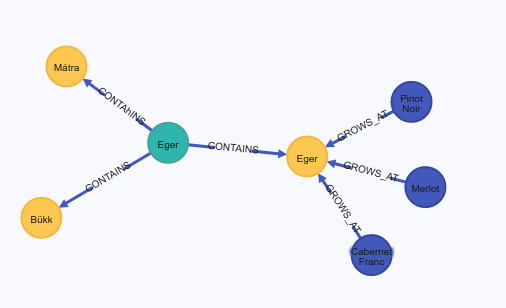I discovered OPTIONAL MATCH when I was preparing the code kata of Test Driven Development with Neo4j.
First, let’s have a look at how the test data look like.

You can see that there is one WineRegion, 3 WineSubregions connecting to the same WineRegion and there are Grapes as well. But not every WineSubregion has related Grapes - in our test database.
When I was developing the function to return a given WineSubregion with its parent region and with the grapes which are grown at that subregion, first I wrote something like this (instead of a variable I use a real subregion name here)
MATCH (wr:WineRegion)-[:CONTAINS]->(wsr:WineSubRegion {name:"Mátra"})<-[:GROWS_AT]-(grape:Grape) RETURN wr, wsr, grape
This query only worked if the subregion I was looking for had grapes associated with it. After I thought about it I realized that it must be about that missing relationship. So as a next step I added that I was looking for 0 or 1 instance of that relationship - that’s what I thought at least.
MATCH (wr:WineRegion)-[:CONTAINS]->(wsr:WineSubRegion {name:"Mátra"})<-[:GROWS_AT*0..1]-(grape:Grape) RETURN wr, wsr, grape
Still no result for subregions without grapes grown there. Now I was truly surprised. I expected that if I look for potentially zero relationships then I should have results for any subregions.
In fact, it is so obvious this didn’t work. If you put a number or a range after a relationship type, you don’t define how many relationships there can be between the two nodes - why would you even do that - but you define a relationship length. I’ll cover it in another article, but to give you an idea, you can define how many relationships of a certain type you have to hop through in order to reach another node. With a :FRIEND relationship in a social graph, it makes perfect sense. In my data model, it doesn’t.
Then I found the OPTIONAL MATCH clause. Its name is really descriptive.
After the MATCH clause you describe all the nodes and relationships you are looking for and must be present. Then after the OPTIONAL MATCH you describe anything that is okay not to be there in the database. If the optional elements are not there, they will be represented as null in the results.
MATCH (wr:WineRegion)-[:CONTAINS]->(wsr:WineSubRegion {name:"Mátra"}) OPTIONAL MATCH (wsr)<-[:GROWS_AT]-(grape:Grape) RETURN wr, wsr, grape
Now you know how you can look for optional elements in a graph, next time we will talk about the MERGE keyword.

